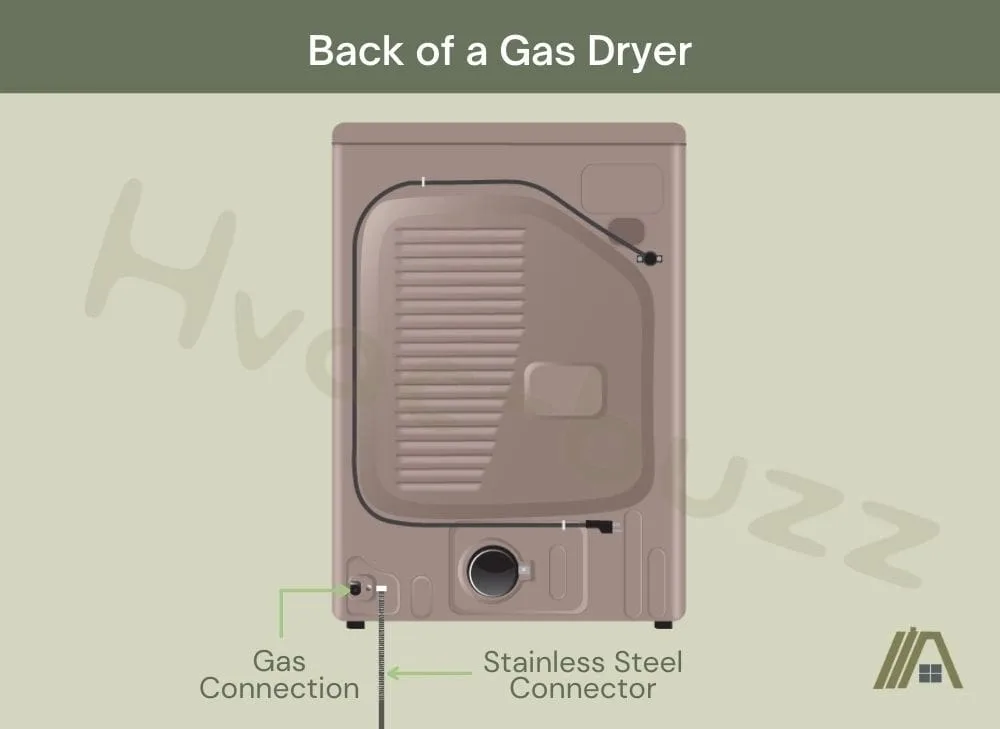When planning routes for your appliances, it is easy to want to take the same path for everything. Not only is it the most efficient route, but it would likely save precious space. Or in other cases, paths often need to cross over each other.
When it comes to your dryer duct and gas line, it can seem risky to have the two touch. Let’s look into why that might be and figure out if you need to change your routing plans.

There are no rules in the IRC that prohibit dryer vents and gas lines from touching unless the dryer manufacturer says that this is not allowed. Dryer vents can get hot enough to soften plastic pipes and increase the pressure of the fas in the pipes, but they cannot melt the pipes or cause gas explosions.
Surface Heat of Dryer Ducts
The most significant worry about having a dryer duct touching a gas line is that the heat of the duct would impact the gas line negatively. This may be potentially dangerous in multiple ways, which we will get into later.
For now, it is important to understand that dryer ducts can get significantly hot. The air that passes through the vents can range between 120 and 160 °F and can even hit up to around 185 °F.
This means that the surface temperature of the dryer duct measures at around 130 °F. If you do not keep up with routine maintenance and your ducts get clogged, however, you can expect much higher temperatures because heat is not able to escape as easily.
Gas Line Materials
While gas lines can vary in material, they are typically made using steel, black iron, PVC, or copper. The materials that gas lines can be made out of also vary by local code. This means that where you live impacts what material you may have.
If your gas line is made out of metal, such as steel, then you do not need to worry about it melting from the heat of the dryer vent. This is because metals have extremely high melting points that are way beyond any temperature your dryer vent could reach.
On the other hand, you may need to be cautious if your gas line is made out of plastic, such as PVC. This is because plastics have a much lower melting point. PVC, for example, has a melting point of 212 °F; however, the material begins to soften at temperatures as low as 140 °F.
This means that your pipes, if exposed to enough heat from the dryer ducts, can become soft and deform.
Another factor to consider, though, is that metals function as great heat conductors. This means that they can heat up any gasses passing through extremely well, which can be a whole other issue.
Gas Ignition Temperatures
If you are scared of the gas line getting too hot and exploding if it touches the dryer duct, you luckily do not need to worry. The gas line transports natural gas to your heating system.
Therefore, in order to combust, your pipe would need to reach the ignition temperature for natural gas, which is over a thousand degrees. So, your dryer duct will not blow up your gas line if the two come into contact.
However, the extra heat from the duct can impact the pressure in your gas line. When the temperature of a gas increases, the pressure will also increase. While it can be regulated with a valve, if the pressure is too high, the gas can cause your heating components to overheat.
While your furnace will often have a regulator, the components in it can easily become damaged from overheating. You will not, however, need to worry about your furnace starting a fire. This is because furnaces have safety protocols in place to shut down if it overheats.
Dryer Vents Can Touch Gas Lines
If your gas line is made out of a proper material that is able to handle the heat and if it has a pressure regulator somewhere, whether that be a valve or furnace regulator, then there should be no issue with having your dryer vent touch your gas line.
To be extra safe, you can insulate your dryer ducts, which has multiple other benefits.

What Does the Code Say?
When it comes to venting dryers, the International Residential Code (IRC), Section M1502 specifically, highlights that dryer exhaust systems should be independent of all other systems. However, they do not mention or stop independent systems from being in contact externally.
In addition, they do not mention keeping gas lines distanced from dryer vents (Section G2415). This means that there is nothing stopping you from having the two systems touch.
Possible Exception
There is a possible exception that can prevent you from having your gas line and dryer duct in contact. Section M1502.1 of the IRC says the following:
“Clothes dryers should be vented in accordance with the manufacturer’s instructions.”
This means that if the manufacturer of your clothes dryer says to avoid contact between gas lines and the dryer ducts, then you have to follow their recommendation to be code-compliant.
Sources
https://homeinspectioninsider.com/how-hot-a-dryer-vent-gets/
https://www.forbes.com/home-improvement/plumbing/what-is-gas-piping/
https://www.creativemechanisms.com/blog/everything-you-need-to-know-about-pvc-plastic
https://www.homeproplumber.com/gas-pressure-testing-residential/
https://codes.iccsafe.org/content/IRC2021P2/chapter-24-fuel-gas#IRC2021P2_Pt06_Ch24_SecG2415

